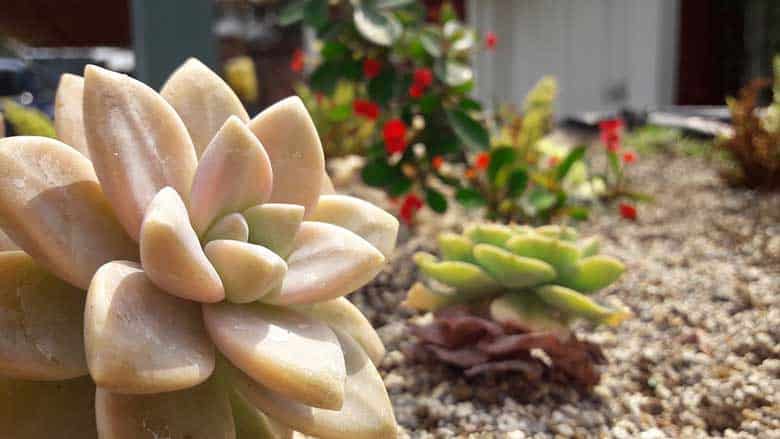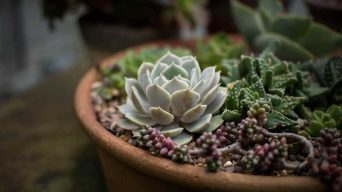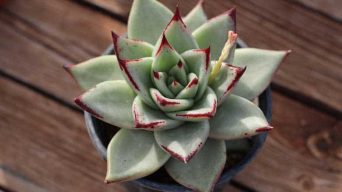Succulent plants are really popular right now, and they can be found in all shapes and sizes.
One of the reasons people love them is because of how easy it is to care for them, whether indoors or outdoors.
Outdoor succulents often have different requirements than indoor plants because they live in a much more extreme environment.
That being said, if you can provide your outdoor succulent with the proper care, then it will be happy and healthy!
In this blog post, we will go over how to care for outdoor succulents so that you can enjoy these low-maintenance plants all year long.
How to Care For Succulents Outdoors
Succulent care outdoors is very similar to caring for indoor succulents. However, there are some slight differences.
The main difference is that outdoor succulents are more exposed to the elements, so monitoring how much sun and water they get is important.
If you can provide them with proper care, then your succulents will be happy and healthy!
Sunlight Requirements for Outdoor Succulents
Outdoor succulents need at least four hours of sunlight a day, so it is important to place them in an area where they will get enough light.
Succulent plants need direct sunlight but do best with bright, indirect light, so placing them in a spot where they will get morning or afternoon sun is ideal.
If you cannot provide your outdoor succulent with enough light, then it may start to look a little bit droopy and discolored.
However, if you place your succulent in an area that gets too much sunlight, then it may start to look scorched and brown.
When this happens, move your succulent to a new area where it will get less direct sunlight and avoid placing it in an area where it will get constant afternoon sun.
Watering Outdoor Succulents
Succulents, like cacti and other desert plants, can go a long time without water.
They store their own water in the plant itself rather than relying on regular watering like most other houseplants or outdoor plants do.
However, this doesn’t mean that you shouldn’t give them any water at all! Succulents need water to thrive, just like any other plant.
How To Water Outdoor Potted Succulents
Succulent plants need to be watered once a week – the frequency of watering depends on how hot your area is and whether or not you have been giving them any sunlight.
They should only be watered if the soil is completely dry.
For succulents in a pot, you can check this by lightly pressing your finger into the soil – if it is still wet, they don’t need any water yet.
If the soil feels dry and crumbly, then that means they are ready to be watered.
When you water them, ensure that the soil is sopping wet and let any excess drain out of the bottom drainage holes.
How To Water Outdoor Succulent Plants in Containers Without Drainage Holes
If you don’t have any drainage holes in your pot for the soil to drain out, then you must water them sparingly.
If you water them too often or apply too much water at once, the potting mix will stay wet and become a perfect environment for fungi to grow in.
This will eventually lead to rot or mold, which can be fatal for succulents.
How Do You Water Succulents in the Ground
Outdoor succulents planted in the ground don’t need to be watered as often, but they do require a decent amount of water every week.
During the summer and in warmer climates, you should water them once a week.
In cooler coastal areas or during the fall and winter months, they can be watered every two weeks.
When they live in a garden, it’s best to wait until your outdoor succulent plants are dry before watering them again.
You should water your succulents in the ground around their base to ensure that all of their roots stay wet.
If you have a small succulent garden, this is best done with some kind of watering can.
The best time to water your succulents is in the early morning.
This will allow them to dry out during the day, preventing mold from growing on their leaves and stems.
Misting Succulent Plants in the Garden or Outdoors
Succulent plants living outdoors in the garden or a planter don’t need to be misted.
Succulents need to be watered thoroughly, not lightly misted because they will not provide enough water.
Also, misting can cause fungus to grow on their leaves if you mist them too often, so it’s best not to do this at all.
What Type of Soil Do Outdoor Succulents Need
Succulents need soil that drains well and doesn’t hold onto too much water.
Plant them in a cactus mix, which is specifically designed for succulents and other desert plants.
You can also use a potting soil mix containing sand, which will help keep the soil loose and prevent it from becoming too compact.
If you are growing succulents in the ground, your best bet is to use some cactus or succulent soil mix. This will ensure that they have the best chance of thriving and surviving outdoors.
For outdoor potted succulent plants, the potting soil mix or cactus mix should be mixed with sand and perlite.
Perlite is a white, powdery volcanic rock that will help to keep the soil loose and prevent it from becoming too compact over time.
When caring for outdoor potted succulents or other types of plants in pots, make sure that you don’t use soil treated with any fertilizers or pesticides.
These chemicals can harm the plants and make it difficult for them to get all of their nutrients from the soil.
What Temperature Do Succulents Need to Thrive?
Most succulent plants like it when the temperatures are between 60 and 80 degrees.
They can handle slightly cooler or warmer conditions but not extreme heat or frost. They will be fine as long as they aren’t frozen for too long of an extended period.
Most succulents are very cold hardy, but if the temperature drops below 50 degrees, they can start to turn black and look burnt on their tips or edges.
If this happens, you need to move your succulent plants indoors or bring them into a greenhouse for winter.
How to Plant Outdoor Succulents
It’s best to plant succulents in the ground during the spring or fall, which is when their growth rates are at their highest.
If you want to plant them outside earlier than that, it’s possible as long as they have some time before winter hits and temperatures drop below 50 degrees Fahrenheit.
Succulent plants are very easy to plant, and all you need to do is dig a hole in the ground that is deep enough for their roots and spread out.
Make sure that there isn’t any space between them, but they should also be spaced apart so they have room to grow larger than what they were when you first planted them.
Ensure that your planting area has bright sunlight for at least six hours of the day, but it’s not in full sun.
Succulents burn easily, so you will want to put them somewhere where they are protected from direct sunlight for most of the day.
When you transplant succulents, it’s essential to water them well and let the soil dry out before you plant them.
This will help their roots get used to being in new soil to adjust appropriately without experiencing any issues with transplant shock.
Do Outdoor Succulents Need Fertilizer
Outdoor succulents are very hardy plants, so they don’t generally need any fertilizer.
However, you can use a diluted liquid fertilizer once a month during the spring and summer to give them some extra nutrients.
This will help them get all of the nutrients they need, and it can also promote their growth and flowering during certain times of the year, depending on what type of succulent plant you have.
When using fertilizers for outdoor succulents, be careful not to use too much.
The soil should be the only thing they are getting nutrients from, so if you start using fertilizers, it can become toxic for them and lead to the root burn or death of your succulent plants.
Pruning Outdoor Succulents
Generally, you shouldn’t have to prune your succulent plants unless they grow weirdly or get too large for their pots.
If the plant is full and healthy-looking with lots of leaves, it shouldn’t need maintenance other than regular watering.
You can also cut off dead leaves from the bottom of your succulents if there are any but only do this a few times a year.
If you remove too many leaves, your plant can stop growing and start looking scraggly or sparse.
Pruning succulents is a great way to get rid of dead material, but don’t take off too much from the plant or try to do it very often.
The best time to prune your succulents is during the spring or summer when their growth rates are at their highest.
Common Problems With Outdoor Succulents
Succulents are tough plants, but they still have their problems.
They can experience sunburn when placed in direct sunlight for too long.
If this happens, the best thing to do is just move it out of the sun until its skin heals itself.
Another problem that outdoor succulents can run into is overwatering.
This can cause root rot and kill the plant. You should always wait until the soil is completely dry before watering your succulents again.
Common Diseases of Outdoor Succulents
Unlike indoor succulents, outdoor plants face several environmental threats.
They are exposed to rain, wind, and sun, which can cause problems in the garden where they grow.
Outdoor plants must withstand these conditions but may still succumb to common diseases that affect them.
The most common diseases that affect outdoor succulents are:
Powdery Mildew
This disease is caused by a fungus that lives on the leaves of succulents.
It attacks new growth, although it can remain dormant for months if there are no suitable conditions to grow in.
The best way to prevent this disease from occurring is to keep your succulents dry by not over-watering them.
If the plant leaves do get infected, you can remove all affected parts and spray with a fungicide.
Root Rot
Root rot occurs when roots are exposed to stagnant water for long periods – especially in winter, where colder temperatures cause slower plant growth rates.
The roots will rot away, causing the plant to die off if left untreated.
If you suspect your succulent is suffering from root rot, make sure there are no longer any waterlogged areas in the pot and transplant it into fresh soil with good drainage – using a cactus mix rather than regular garden compost.
Common Pests That Affect Outdoor Succulents
As well as succulents being vulnerable to diseases, they must be kept free from pests if you want them to remain healthy.
The following three insects are likely to attack outdoor plants:
Aphids
These tiny black or green bugs feed on the sap of succulent leaves and stems, causing damage that may lead to rot in severe cases.
Aphids can rapidly reproduce, making it essential to determine the most effective way to eliminate them without causing additional harm to your plant. Using a bug spray made with natural ingredients is often more effective than pesticide sprays.
Slugs and Snails
These creatures love eating tender new growth, which attracts them to the juicy stem tips of young succulents that grow in spring and summer.
They can cause extensive damage, causing the plant to wilt and die if not dealt with quickly.
Using a copper strip around your plants is an effective way of keeping them away from your succulents – slugs are particularly sensitive against contact with metal.
Spider Mites
These tiny insects colonize on the undersides of leaves, where they suck up sap until it dies off, leading to yellowing leaves that fall off too.
As well as ruining new growth, spider mites can also block air circulation, which causes infestations to spread rapidly, so you need to act fast!
Treatments include using neem oil or insecticides containing pyrethrum but be sure to only use these when you have removed any affected leaves and only spray the undersides of leaves.
Preventing Problems With Outdoor Succulents
There are several ways that you can prevent problems with your succulents growing outdoors.
The first is to ensure that the plants have enough room for their roots – outdoor conditions will usually be different from indoor succulent plants, so they need more space to grow, which means repotting them every year depending on how big they get.
Another way is to protect new growth in spring and summer by covering it overnight using a sheet or tarp, preventing any damage from pests trying to nibble away at young plant matter during darkness when they’re less active.
You should also ensure that your succulents are given enough water.
Outdoor conditions can vary depending on the season, so it’s important to only give them what they need instead of overwatering them and causing problems like root rot.
If you’re unsure how much water to give your succulents, stick a finger into the soil.
If it feels dry an inch below the surface, then that’s all they need – overwatering them will only cause problems in the long run!
Lastly, if you want to keep pests at bay, don’t leave any plant debris on top of your plants where slugs and snails can hide out during winter months when there isn’t enough heat or light for them to thrive outside.
All this extra care should mean that your outdoor succulents stay healthy with minimal effort from yourself, so enjoy watching them grow throughout summer and autumn before coming back inside when temperatures drop!
How to Care For Succulents Outdoors in Summer
Succulents are plants that have adapted to survive in dry areas by storing water. They may even go for weeks without any rainfall, but they still grow and bloom amazingly well.
If you want an outdoor succulent garden with lots of colors all summer long, consider growing perennial succulents as part of your landscape design.
There is no need to water them often during the season because they will soak up rainwater instead when it does fall from the sky.
However, there are a few other things to do for succulents to thrive outside.
For one thing, they may need protection from too much sun.
Succulents don’t like intense heat or very high temperatures because it can cause their leaves and stems to dry out completely.
When it comes to outdoor succulent care, one thing that can help is adding mulch around their base, so they don’t have to fight off the weeds competing for water and nutrients in the soil.
A layer of stones or gravel will keep your plants looking neat and tidy while still allowing them to get the water they need.
Once you have succulents in your garden, you should do only a few other things for their care during the summertime.
For one thing, it’s important not to over-fertilize them because too much fertilizer can burn out or kill off these plants easily. You’ll know that you’re using too much fertilizer when your succulents start to look pale.
Also, they may need some extra protection from pests such as aphids or spider mites that can suck the sap out of them and destroy their leaves entirely.
If you notice small insects crawling all over your plants’ stems and foliage, it’s time to take action and spray an insecticide.
In addition to that, you should keep a close eye on the amount of water they receive because succulents don’t like being overwatered.
If you see too many yellow leaves, it’s usually a sign that your plant suffers from a disease or not enough water.
Finally, be careful when planting succulents in a pot or container with other plants because they may need more water than most.
You can tell if this is the case when their leaves turn brown and dry up completely. To prevent that from happening, consider adding rocks at the bottom of your planters, so it doesn’t get overwatered.
All in all, succulents are very easy to care for, and they add a lot of color to your garden. They will even save you time and energy while still looking beautiful on the patio or front porch throughout summertime!
How to Care For Outdoor Succulents in Winter
Winter is a difficult time for succulents.
During the winter months, you should keep your succulent outside in an area that gets six hours of sunlight each day (ideally).
If it snows during this period, tuck some pine branches or other evergreen foliage around them to provide protection.
You should also cover them with a sheet of plastic to provide an insulating layer.
Winter is a time when succulents need very little water. Water the plant only once every two weeks and do not fertilize them during the winter months.
Most succulent plants go dormant during this time, so it is important not to disturb them.
You should bring succulents inside in the winter if you live in a region where temperatures drop below freezing.
You can keep your succulent inside on a windowsill and move it outside when spring arrives.
Final Thoughts
Succulents make a great addition to your garden or front porch.
They add color and life to an area while still being low-maintenance plants. For them not to die on you, though, they must get the proper care needed to have a healthy and long life.
Some of this care includes being planted in the right type of soil, getting enough light (but not too much), and having proper watering schedules such as once a week during warmer months and only when needed during colder times.
Your succulents will grow to be hearty plants that can survive the weather and be outdoors by following these steps.
Succulents are a type of plant that can be indoor or outdoor plants depending on where they are located, how much light is available, what kind of soil it’s planted in, etc.
For succulents to survive outside elements such as rain and wind, they need to have care taken to live long and healthy lives.







